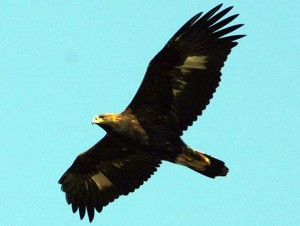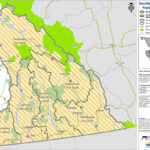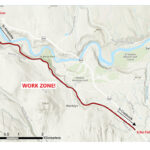Home »

Eagles migration in the Rockies
Look, there’s a Bald Eagle gliding through the gap!
And, what’s that circling the peak? It’s big, dark, and now there are two of them.
Two adult Goldens, right Vance?
Golden Eagles are among the largest, fastest and nimblest raptors in North America. Lustrous gold feathers gleam on the back of its head and neck; a powerful beak and talons advertise its hunting prowess.
On the Spring Equinox, Rocky Mountain Naturalists joined Vance Mattson at a viewing site near Wasa Lake to witness the incredible migration. The migration was discovered by chance 24 years ago, in the Kananaskis Valley near Mt. Lorette.
On March 20, 1992, Peter Sherrington and Des Allen were conducting a general bird survey in the Rocky Mountains south of Banff. Late in the morning, Peter observed an adult go soaring high above. Soon they saw two more and then another small group. By day’s end, Peter and Des had counted over 100 Golden Eagles migrating north.
Two days later, Peter led a group of naturalists to look for eagles; they were rewarded by the sight of 250 of the big, dark birds moving northwest in a single afternoon.

Until this time, it was generally accepted that only relatively low numbers of Goldens migrated, mainly through the Rocky Mountain foothills, that most of the birds were immature and that they were not moving long distances. This model was now to forever change. Over the next few years, groups of observers began to find other sites at which eagles could be seen between the Crowsnest Pass and Jasper.
Each spring, large numbers of Golden Eagles fly from their wintering grounds in the mountain states of western USA to breed in Alaska and Yukon. They return south in the fall. The populations are widely scattered on the breeding and wintering grounds and almost impossible to study.
Along the migration routes, they pass by in relatively narrow streams, and large numbers can be observed. In addition to observation sites in the front ranges of the Alberta Rockies, regular observations occur near Cranbrook. The first Goldens head north in late February, peaking between mid-March and the end of April, and ending late May. In fall, some head south in late August, peaking mid-September until early November, and ending in early December.
Migrants roost on ridges during the nights and start moving soon after dawn. Typically, in good migrating weather, the movement builds during the morning and reaches a maximum in mid-afternoon. Movement stops at dusk; birds can often be seen settling on the peaks.
Big movements cannot be predicted. Often, perfect migrating conditions produce few sightings because the ‘flow’ may be blocked by poor conditions elsewhere. At other times, our own bad weather is the cause.
For weather ‘comfort’, together with plenty of eagles, early October is the best time of year. Beautiful warm days along with wonderful fall colours provide an amazing experience.

The ridges of the Rocky Mountains parallel the eagles desired migration route. Also, they trend at right angles to the prevailing wind, generating strong updrafts. When wind conditions are right, the eagles sail by at over 100 km per hour with hardly any effort. Even on calm days, thermals forming over peaks can propel the birds up to great heights. From here, in a shallow, diving glide, they can travel to the next thermal, and on to the next ‘elevator’. When a number of eagles are soaring together, the group is called a ‘kettle’. Kettles are a magnificent sight with as many as 60 eagles spiralling upwards.
The mountains rimming the Rocky Mountain Trench are thought to provide a near perfect route for migrating eagles. A perfect viewing site would offer close viewing along a topographic feature that funnels the raptors. A clear, unobstructed view, along with experienced observers, will contribute to success. Luckily, both sites near Cranbrook offer many observable raptors, plenty of good people and easy access.
In the fall of 2009, Vance Mattson conducted the first extended reconnaissance count at or near the Steeples ridge. Of significance, this location is about 80 km due west of the established Piitaistakis-South Livingstone site, giving the possibility of simultaneous monitoring of movement along the east and west flanks of the Rocky Mountains at the same latitude.
The ‘Scarface’ site is a convenient option east of Wasa Lake. Situated near Grundy Lake, the site offers views of the birds as they pass over or in front of the high ridge. Observers may have to contend with neck strain, also known as ‘Warbler Neck,’ due to the relatively high angle of observation. The site nestles up against the steep wall of Scarface Peak (2,400m) which is the most westerly and visibly craggy peak of Mount Bill Nye (2,600m).
The South Lakit site is located on a spur road of the Wildhorse Forest Service Road, at the southern base of Lakit Ridge, with Lone Peak to the SSE and the Steeples commencing just beyond. Observation from this site, especially in the fall, is very favourable. The birds generally appear at low altitudes as they follow the natural descent of Lakit Ridge.
There is little obvious relationship between weather and the amount of raptor movement. Raptors move on both sunny and cloudy days, calm days and days with strong and moderate winds from various directions. Raptors also migrated when ridges were partially obscured, by moving below the cloud base at lower elevations. Often, a ‘big’ day occurs following a couple of days of snow and low overcast conditions.
A ‘big’ day could consist of 80 birds; 70% Golden Eagles, 25% Bald Eagles, a few Turkey Vultures, Northern Harriers, Sharp-shinned Hawks, Red-tailed Hawks and Rough-legged Hawks.
During an average year, observers can spend over 15,000 hours counting tens of thousands of migrating raptors, 80% of which are Goldens. Thanks very much to citizen scientists such as Peter, Des and Vance who make a huge commitment to furthering our knowledge of the mysterious birds. Check out ‘Rocky Mountain Eagle Research Foundation.’
To identify a Golden Eagle; they are usually found alone or in pairs, soaring or gliding with wings lifted into a slight ‘V’ with the wingtip feathers spread like fingers. They capture prey on or near the ground, locating it by soaring, flying low over the ground or hunting from a perch. Sometimes seen attacking large mammals, or fighting off coyotes or bears in defence of it’s prey and young, the Golden Eagle has long inspired both reverence and fear.
For more information on Eagle migration, viewing sites or current Naturalist activities, check rockymountainnaturalists.org
Lead image: Greg, Vance and Jo Ellen (L-R). Photo by Helga, a naturalist.
– Submitted by Daryl Calder on behalf of Rocky Mountain Naturalists.







